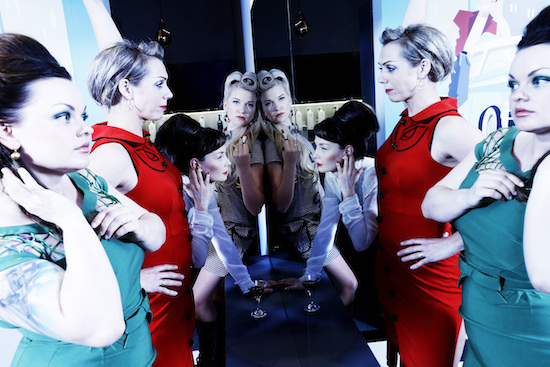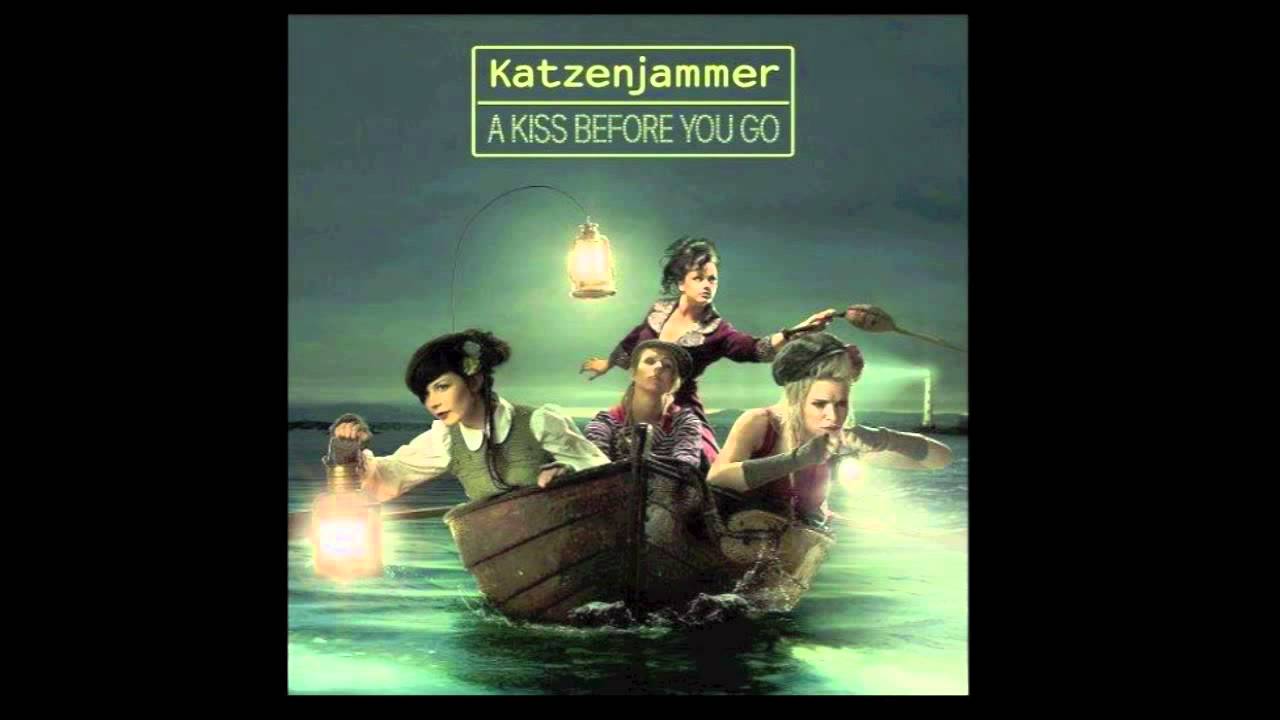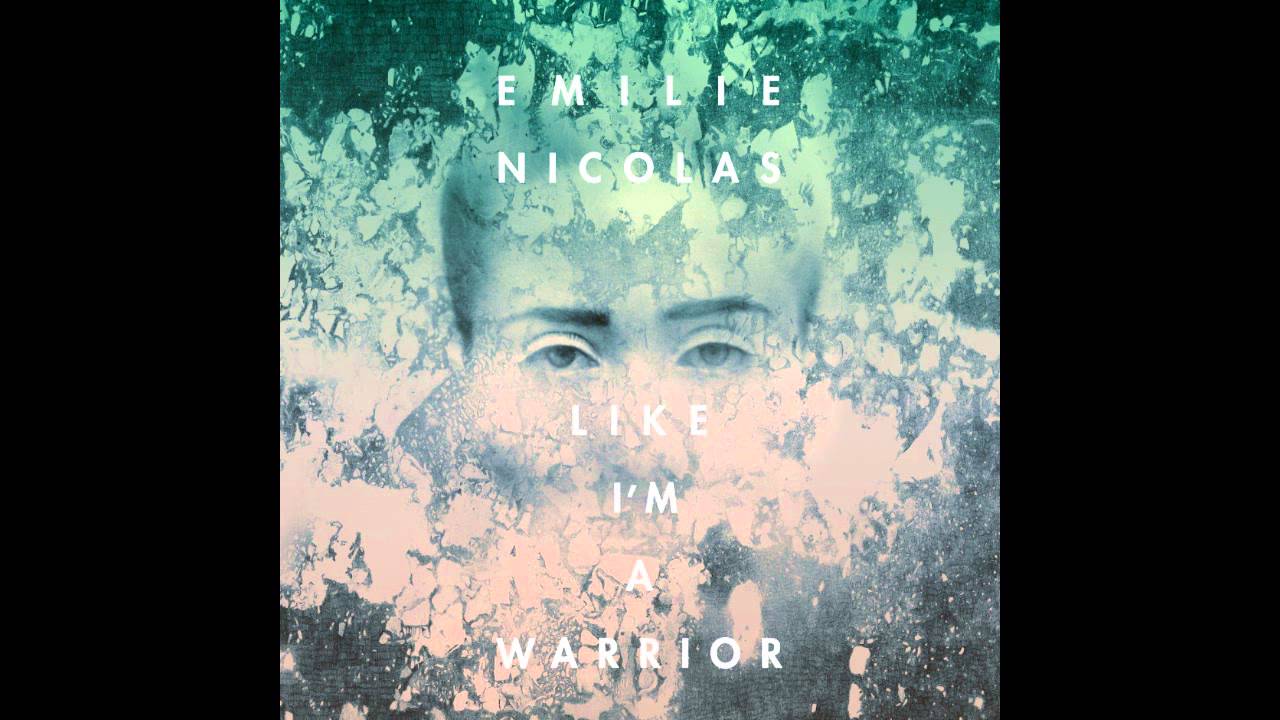Oslo in January is a very cold and empty place. The streets are caked in ice and snow, doubling walking times in the city (lest you dismantle your coccyx slipping over, banana peel-style at the next zebra crossing) and what with the fog and overcast skies to boot, the streets can wind up half empty at the best of times. But the atmosphere downtown in Oslo’s Sentrum Scene venue is heating up. Thousands of Norwegians of all shapes and sizes have gathered for the launch of a new album, and the start of a new era for Norway’s continually rising folk-pop quartet, Katzenjammer.
The quartet of multi-instrumentalists have been together for a decade by this point, touring relentlessly, and winning over swathes of northern Europe with their earworm-heavy brand of burlesque-styled songs. Each member plays a vast array of instruments, and they constantly swap banjos, accordions and vocal duties – as well as the drummer’s chair and their signature oversized contrebasse balalaika, Akerø (as well as a name, it has its own Facebook page).
Initially assembling to perform songs written by their friend and collaborator Mats Rybø, the group quickly gained a reputation for raucous live performances, with their music initially characterised by its circus and burlesque-like aesthetics. All crazy costumes and accordion keys, with tracks names like ‘A Bar In Amsterdam’ and the sea shanty-esque ‘Hey Ho On The Devil’s Back’. Their first studio album, Le Pop, released back in 2008, breached a wider audience after the quartet made it to the finals of Urørt, an unsigned bands competition held by the NRK, the Norwegian equivalent to the BBC, earlier that same year – and managed to chart in both their native Norway and the Netherlands. Their second, A Kiss Before You Go, continued the circus, cabaret and seafaring aesthetics, breaking through to chart throughout central Europe. The album also garnered several positive reviews in the UK, and highlights included an unexpectedly genius reworking of a Genesis track from the height of the absurdly poppy Phil Collins era in the 80s, ‘Land Of Confusion’. After the success of A Kiss Before You Go, and a tireless tour schedule, the foursome took a year off, making key pilgrimages to musical havens like Nashville and London.
The songs on their latest full length, Rockland, are some of their outright catchiest to date, and unlike their first two albums, songwriting duties were split pretty evenly between Anne Marit Bergheim, Turid Jørgensen, Solveig Heilo and Marianne Sveen, with their former chief songwriter Mats Rybø only making a fleeting appearance in the album credits. The music’s evolved, taking on something of the Americana and British folk sounds that the band have long admired, and it’s the distinct voices of each member which are now clearly discernible, as if the make-up and costumes have once and for all been shed. Album opener ‘Old De Spain’ sets Bergheim’s deft banjo playing in a stomping folk-blues number straight from the Cohen brothers’ O Brother, Where Art Thou? soundtrack, while Heilo’s ‘Oh My God’ sees her rapping over ukes and accordions, and the title track – referencing the mental hospital in Allen Ginsberg’s Howl – is an anthemic folk festival classic in the making. Rockland is feel good, folk-tinged pop music of the highest order – all the more abundantly clear in their reception at Oslo’s Sentrum Scene. The vast majority in attendance have never heard a note of Rockland before, yet the infectious new choruses hit home immediately, getting the warmest possible reception from a pumped crowd. The highlight however, remains the Mats Rybø-penned, American gospel-style, ‘God’s Great Dust Storm’ from A Kiss Before You Go. Save from a kick and floor tom from Solveig, the group go a cappella, and Sveen steps up to deliver a stunning lead vocal performance backed up by three angelic harmonisers.
The style on the new album is quite a departure, lessening the influence of circus, burlesque and Balkan music, and I notice Rybø’s credited on far fewer songs.
Marianne Sveen: We’ve been playing together now for ten years, and when you do that you make your own sound, no matter if you try or not. I think the change is just natural development really.
There’s definitely an extra element of Americana on this album – there’s a dobro in there now, and it seems like the banjo features more heavily.
Solveig Heilo: I think this is just a natural development. At the beginning we were hugely influenced by the soundtrack to Oh Brother, Where Art Thou?, the sirens and the chanting, and you’ve got the banjo playing on there – and that was a big part of it at the start. We even covered ‘Man Of Constant Sorrow’, so it has been a natural part of Katzenjammer from the beginning, and now we can just nurse it more.
I really liked the dobro playing, especially at the gig in Oslo [Anne Marit] plays it really amazingly. How recently did you pick it up?
AMB: The dobro sounds amazing! I’ve had the instrument for a while, at least a couple of years I think, but it’s just been standing in the corner, and I thought… ‘I don’t know how to approach you!’ Then suddenly it felt natural. I don’t play it the ‘right way’ though. I’m tuning it differently and doing it my way, but that’s sort of the point with Katzenjammer. Whatever works, works.
So tell me about that giant balalaika…
Turid Jørgensen: We’re a bit tired of it ’cause he won’t work with us at the moment! It’s sometimes quite hard to amplify when there’s a lot of guitar and drums, and recently he’s been making this loud ‘RAR!!’ sound – I was talking to a guy today about fixing him in fact. So we found it by total accident. We played this place in Oslo two times about a year apart, and we saw this instrument back stage in the corner and thought what a great instrument, then when we came back a year later it was still there with dust all over it. So we thought, as nobody’s using it, let’s ask if we can buy it!
SH: At some point we tried to travel with him from London, and they refused to bring it on board the plane, because we had this huge case. It looked like the coffin for Dracula and his friends.
…and you can’t bring a dead body on a plane of course.
SH: So we had to take the case into two pieces and send them separately, and then the balalaika got his own boarding pass, and we put the accordion in his name too (so he had it as his hand luggage!) and he got to fly with us.
So Rockland is a reference to Allen Ginsberg. What themes does that bring up and how are they reflected in the album?
AMB: The lyrics [on the title track] are written by Mats Rybø, as he’s a huge Ginsberg fan; and also he wrote it to Katzenjammer as well. Rockland is a mental institution, but Katzenjammer is an institution too, but it’s like we’re in this bubble together and we all really understand each other. It’s just about being with somebody who really understands you, together in this small universe inside the big universe.
What about the song, ‘Curvaceous Needs’? What’s that one about…?
MS: [laughs] Me! It started with me getting a lot of messages on my Facebook from big girls and curvy girls, telling me how they’re self conscious about their body, and unable to be comfortable, and that when they saw me on stage – with all my… body – they got inspired to be more confident. And I thought, why shouldn’t anyone be? So that’s one part of it, and the other part of it was hearing from friends about other girls trying to make a pass at their men. It’s maybe just like a little middle finger to the girls trying to get other people’s men, sort of saying, ‘He likes his curves anyway, so go ahead and try it all you want.’
It’s a bit cheesy really, but the underlying message is just to be proud of who you are. It was all inspired by when I got all these messages from girls saying, ‘If you can stand there in tight dresses and wiggle your ass, then we should as well.’ Why shouldn’t anyone?
You’ve played in England quite a bit in the past – various folk festivals, and Glastonbury, plus you played the Lexington recently. How have you found British audiences? How do reactions differ across Europe?
SH: Depends a lot on where we are in England of course. Glastonbury and the Cambridge Folk Festival were both crazy, but London is sometimes a little bit more reserved. The further up North you get, the looser the audience I think. When you get into Scotland especially.
AMB: I was saying over breakfast today, I just really enjoy being around Englishmen. I enjoy playing to all of our audiences of course, but there’s something about the humour here that I feel so comfortable with. The sarcasm and irony are so great. We don’t get that in….
MS: …some other places! Not naming countries…
I’m always very interested in the phenomenon of European bands very often singing in English. How do you feel it developed for Katzenjammer? Why do you not sing in Norwegian?
AMB: It was pretty natural as Mats wrote those original songs in English, and the English language is just easier to write lyrics in. It’s got so many words to describe a certain feeling or state of mind that we just don’t have.
SH: And we listen to a lot of English language music as well.
That’s the thing. When you were learning to play and sing a song, you presumably learnt songs in English I guess?
MS: Yeah, everything from The Beatles to Guns N’ Roses or Aretha Franklin.
SH: That’s the main reason for me. You know, I started off listening to Michael Jackson on the radio, and never really listened to Norwegian music. It’s only really now I hear Norwegian bands, and they all sing in English – so I had no relationship to the Norwegian language and music.
TJ: I listened to Norwegian music, but I think for us as a band, it was also important to go international as well. So there are many reasons we chose English. I listened to a lot of Norwegian music when I was a kid though, and I snuck in a bit of Norwegian into one of mine on this album!
MS: I personally write in Norwegian for other projects – but it’s something different.
The Norwegian music scene seems to be really good at the moment. You’ve got acts like Jenny Hval and Susanna, plus Royksopp, and a whole host of black metal and jazz and electronic music. What makes Norway a good place for music? It seems more active than similarly small countries.
MS: Have you heard Emilie Nicolas? She’s amazing, you have to check her out!
MS: I think it’s because there are only five million people. There are not too many struggling for the attention, and there’s room for developing. I think no matter what country you’re from that will always go up and down in waves. I think we’re also really privileged to live in a country where you can get scholarships and financial support to go abroad and so on. Although in our case, we did have to borrow money at the start! But mainly it’s not like in London, where you have…
Something closer to ten million people.
MS: Yeah, nearly double the entire Norwegian population, and a lot of them are trying to do music.
SH: Sweden’s always been quite successful though, and they’ve always been our ‘bigger brother’, especially in terms of music and culture, but Norway’s only really just come to the maturing point now. We have good producers and systems now, and have only just started working out what the management and booking agents need to do – it takes a long time to develop all of that. Everything is only just starting to get much more professional.
Rockland is out now on Propeller Recordings. Katzenjammer continue their European tour at the Palladium in Cologne on March 4, starting a run of dates in the UK on May 8 at the Rescue Rooms in Nottingham; for full details, head to their website




